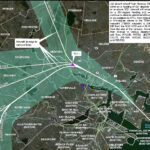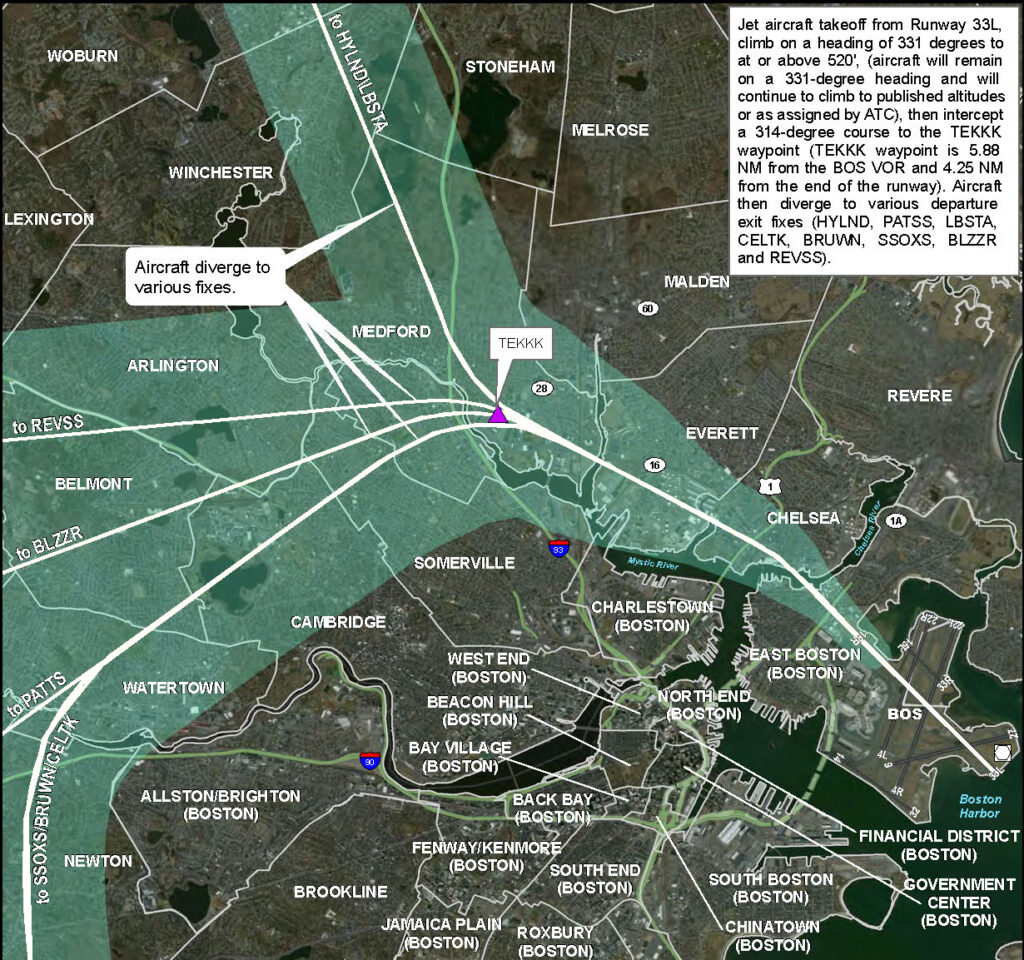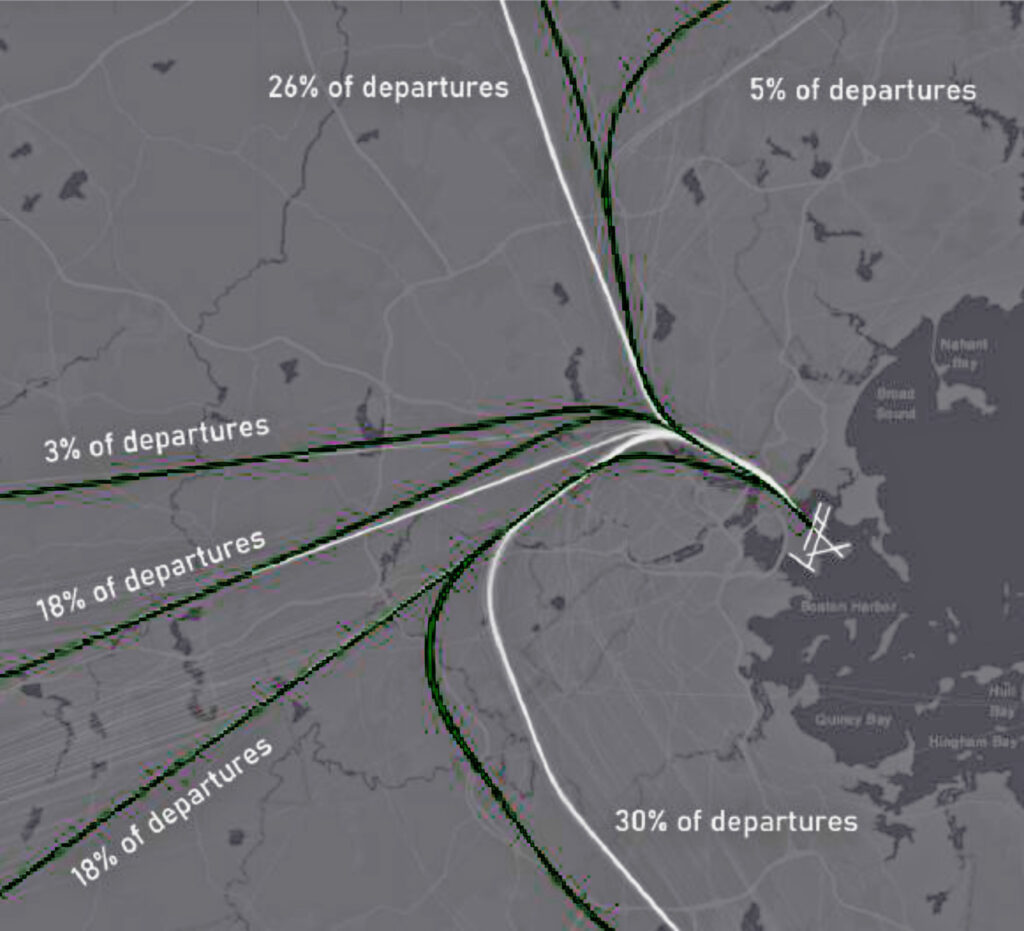
By Rachelle Reinhart with contributions from Myron Kassaraba
Airplane noise over Belmont increased after major changes were made to air traffic control at Logan Airport in 2001, when the United States Congress authorized the Federal Aviation Administration (FAA) to modernize air traffic control under a program called NextGen. NextGen moved air traffic control from a radar-based system to a GPS-based area navigation system (RNAV).
RNAV allows aircraft to travel using a computer programmed with precise waypoints—designated flight path transitions—and GPS coordinates to control the plane’s flight path. Before RNAV, air traffic control instructed pilots to make turns and altitude adjustments during takeoff and landing based on what they saw on their radar screens. This controller-based system had built-in variability so flights were more widely dispersed and noise was more equitably distributed across Boston-area communities.
In 2013, the FAA approved plans for the final RNAV change at Logan Airport: to control flights departing in a northwest direction on runway 33L. When winds blow in a northwest direction, aircraft arrive and depart on runways 33L and 27. The balance between those two runways has changed over time, with 33L being used more frequently. Runway 33L/15R, Logan’s longest runway, has recently been used for more than 20% of departures, while the northwest configuration is used more than 30% of the time.

White tracks show the dispersion of 33L flights after the NextGen/RNAV reconfiguration. Source: Massport/Boston Logan International Airport Runway 33L RNAV SID One-Year Post Implementation Report.
Medford, Cambridge, and Somerville bear the brunt of low-altitude departures from runway 33L, with planes continuing over parts of Arlington, Belmont, Watertown, and Winchester. Medford is the waypoint (TEKKK on the map), and flights barely reach 3,500 feet there, blasting deafening noise and pollution on Medford residents and schools. But three of the four flight paths emerging from the Medford waypoint extend over Belmont, making our town a well-traveled corridor for flyovers as low as 4,500 feet.
At the last meeting of the Massport Community Advisory Committee (MCAC) in February, community representatives learned that the high noise levels over the past six months from 33L overuse were apparently due to a construction project and building crane on runway 27. We had no knowledge of this issue until Massport divulged this information. I understand from other 33L community members that the construction work has ended, and 27 is back in regular use. More information on noise abatement and runway use decision-making can be found on the Massport website.
What has the MCAC been doing?
Towns affected by 33L runway changes have been advocating for a review of the 33L RNAV procedure since the fall of 2013. This effort has been supported by leadership from the affected cities and towns, state legislators, and our congressional delegation.
In October 2016, the FAA and Massport announced that they had engaged MIT’s International Center for Air Transportation in what was called the RNAV Study to explore possible modifications to the flight paths at Logan.
Over a five-year period, MIT, Massport, the FAA, and 33L communities explored several options for increasing aircraft dispersion. In 2020, representatives from the 33L communities requested the MCAC ask the FAA about feasible alternatives. The FAA only endorsed one alternative (2D-2 of the RNAV Study).
The 2D-2 alternative would have introduced several new waypoints with the most frequently used southern RNAV path turning sooner over Somerville. This proposal was reviewed and unanimously rejected by the 33L communities because it did not disperse flights to make the noise burden more equitable.

Original RNAV paths in white against the proposed new flight paths in black. Source: Massport MIT Block 2 Departure Procedure 2D-2 Recommendations Boston Logan 06-2021
In the 2D-2 case, planes flying the route closest to Fresh Pond and over the Grove Street neighborhood in Belmont would fly at an even lower altitude than before. The concentrated noise was also shifted from some communities to others.
Other ideas had been offered up by community members including using the traditional radar system of air traffic control vectors during low-peak periods. But according to MIT’s study, it would be cumbersome and confusing to keep switching between radar and GPS controlled systems.
Myron Kassaraba, Belmont’s long-serving MCAC Representative, summed it up at his last meeting, saying, “The FAA will only ever make changes that are good for the airlines. Communities are an afterthought to how they regulate themselves and make decisions about procedures. There’s a name for it—it is called Regulatory Capture. Here’s the definition: ‘Regulatory capture is an economic theory that regulatory agencies may come to be dominated by the interests they regulate and not by the public.’”
The FAA has stated that they are no longer working on any 33L RNAV procedure alternatives.
Possible solutions
Faced with similar NextGen/RNAV flight reconfigurations in Europe and the United States, some city airports have responded with more thoughtful and calibrated runway-use procedures. For example, the Minneapolis-St. Paul airport has established a layered set of runway priorities based on factors beyond wind direction like peak and low usage, takeoff requirements, and parallel alternatives, to minimize noise impact on residential communities. In January 2023, Minneapolis-St. Paul airport could use priority flight paths over industrial centers and other nonresidential areas about 56% of the time; in December, this was 51%. I will be proposing this option at MCAC, understanding fully that Logan is a high-wind coastal airport.
Another path forward is legal action. Other cities affected by these RNAV changes have filed lawsuits against the FAA. The FAA has argued in the past that the required initial 60-day public hearing period for comments about the new implementation has expired.
Scottsdale, Arizona, proved that no such public announcement took place, which advanced their case. But in 2022, the US Court of Appeals denied their petition, arguing that Scottsdale could not prove the city suffered actual injury or harm to its property from Phoenix Sky Harbor Airport flyovers. This is why documenting evidence of noise disturbance and disruption is crucial to any future remedies Belmont and the 33L communities may decide to pursue.
What can Belmont residents do?
First, it would be helpful to understand and communicate the impact of runway 33L’s overuse on the quality of life for Belmont residents. Data can help pinpoint the number and location of people affected by aircraft noise and document the impact of unrestrained flyovers on personal lives, from feeling forced to relocate to experiencing changes to physical health and emotional well-being.
Please take the community survey about your experience with Logan Airport aircraft noise on the new Belmont community blog and forum, PeacefulSkiesBelmont.org. You can find news and updates on the blog, contribute comments to the forum, and learn about opportunities to bring your knowledge, expertise, and personal and professional network to help us find solutions. This website is not affiliated with either the town of Belmont or the Logan MCAC.
Second, please file complaints with Massport when you’re bothered by flight noise, and ask your friends and neighbors to do the same. Massport and the FAA track and monitor the number of complaints made across residential communities. Note that they also track and post how many complaints come from the same household. For this reason, everyone impacted by noise should be making their feelings heard.
To register complaints quickly, I use Airnoise, which automatically sends complaints to the Massport website each time you press a button on the dashboard. Once you sign up and send complaints, your Airnoise dashboard shows the carrier, aircraft type, departure or arrival, and altitude.
Importantly, this dashboard also helps gather detailed information about the disruption and disturbance to Belmont residents caused by the heavy sequence of flights. I think there is a perception among those not affected by RNAV that people who complain are oversensitive to noise or reacting out of a sense of privilege and entitlement. The timing and altitude of repeated flyovers and the fact that heavier carriers use the long 33L in higher proportion make clear that this disruption places an undue burden on all unfairly targeted residential communities. Along with survey data collection, I will soon be providing space on the community blog for Belmont residents to share their Airnoise dashboards so we can better document the harmful effects on quality of life.
Please visit the Peaceful Skies Belmont community website, register for news and updates, comment, and share your interest in bringing knowledge and skills to help. We can organize a public meeting if new developments require full community feedback. You can also email me directly with questions or comments at peacefulskiesbelmont@gmail.com.
Rachelle Reinhart is the Logan Massport Community Advisory Committee representative for Belmont. Myron Kassaraba, former Logan MCAC representative for Belmont, contributed to this article.


Sorry, the comment form is closed at this time.